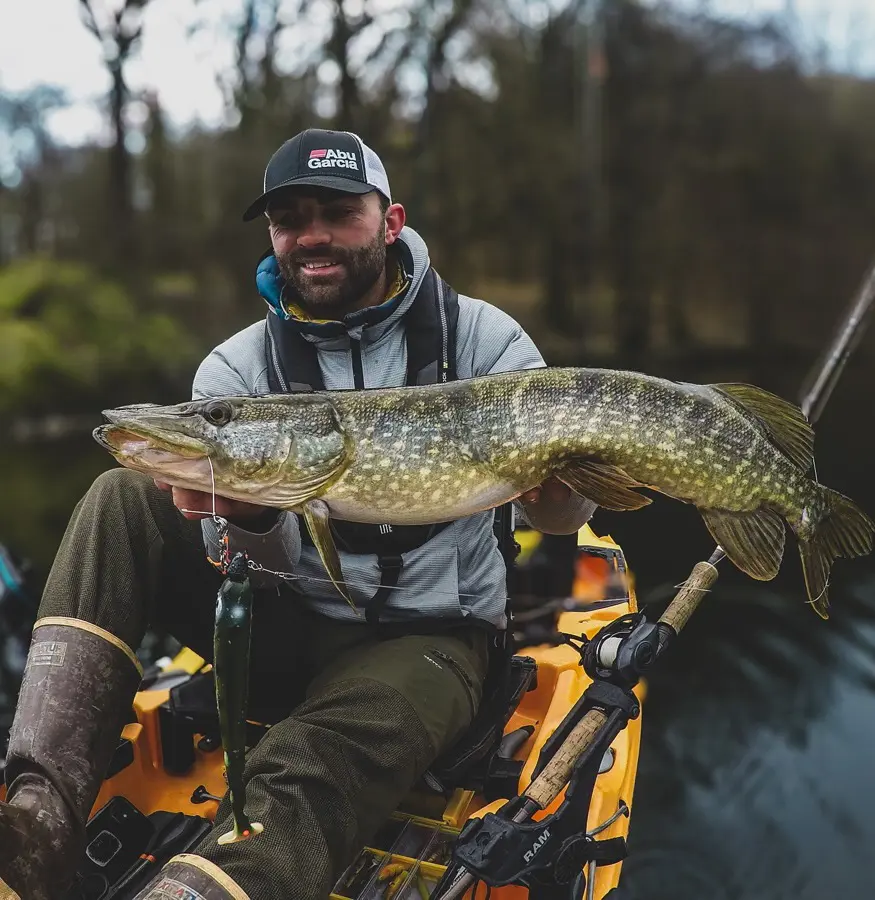Winter is the ideal season to go pike fishing or northern pike fishing, with cooler water temperatures and frost on the ground. Pike are a species associated with winter. It can be difficult to target these predators.
Pike are commonly referred to in terms of length, with anything above 35" considered a huge fish. Pike under 30" are skinny and difficult to catch, but once they reach 30", they begin to gain girth and become a larger fish. Here are some ways on how you can go pike fishing:
1. Look For Prey Spots
When fishing for species such as roach or carp, you build a swim using feed to attract and hold them. It's not the same with pike; instead, you have to put in the effort to identify where they're most likely to be, which, as a predator, will be near their food supply, prey fish. The location of prey fish is determined by the time of year and, more crucially, the temperature of the water.
- Warm Water: The prey fish will be spread out, mainly in shallower places, thus the pike might be anywhere.
- Cold Water: As the mercury lowers in the fall and winter, the roach and bream that pike feed seek a more consistent temperature in deeper water and shoal together in these areas.
2. Finding Pike and Casting Lure

Certain features in the water are ideal for finding pike. Search for drop-offs that have been identified as holding points for predators like a pike, which can wait in deeper water for prey fish to move in or out of the shallows before striking. Check any type of structure, since these are known to hold pike.
Pike-like dark, hidden corners where they may wait before dashing out to consume any fish that comes within striking distance. Moored boats on canals and rivers are also worth targeting, particularly ones that are lived in during the winter since a modest increase in temperature in the water beneath the boat will attract the small fish, and the pike will come along.
To get pike in these areas, it is best to use lures. No matter if you are fishing a canal, river, or lake, walk about and make a few throws in each area until you get a hit, or else follow with your lure. This frequently indicates where the pike are poised to attack on baitfish shoals. Then you may target this region with dead baits or other tactics, possibly resulting in several catches.
Pike Fishing Lures
Some fishing lures for pike are:
Soft Lures
- Shadtails
- Paddletails
- Jerkbaits
Hard Lures
- Crankbaits
- Spinnerbaits
- Topwater lures
3. Selecting The Best Pike
Pike may be caught using a variety of methods, but you should select the one that works best for you and your fishing conditions. The 3 primary pike fishing strategies are dead bait, lures, and live bait.
- Dead baiting: It is a static strategy that works best in the winter when the water is colder and a pike's metabolism slows, making them less inclined to pursue bait.
- Lure Fishing: It is a considerably more active strategy that works best during the summer months and into October when pike will follow bait. It is also more effective at finding fish when they are spread out since it is a method that covers a large area of water.
- Live bait Fishing: It is a type of middle ground between the two as it provides a live, moving prey fish, but one that is held inside a specific area, making it an excellent technique when the pike is in the mood for it.
Hence, if you're dead baiting or using lures, make sure you bring a variety with you on your pike excursion. Some days, pike will be caught with a specific bait or lure, but other days, the same method will not work. As a result, having a few alternatives allows you to experiment until you find something that works.
4. Selecting Your Pike Baits

Pikes are both scavengers and hunters, particularly during the winter when they need to preserve energy. This is why deadbaiting can be so efficient, and there are several baits to choose from, the most common of which are saltwater and natural baits.
- Natural Deadbaits: Best for use in waterways with low pressure and deads scoring where pike have spotted hooks in many natural baits.
- Sea-dead baits: Similar to mackerel, they are also more widely accessible and tend to be more durable and cast better.
Simply slamming out a dead bait and waiting might work sometimes; but, there are times when you must make more effort to lure pike with your preferred bait. So, recast often, not only to freshen up your dead bait but also to boost the likelihood of a sluggish pike seeing your attractive dead bait flutter to the base and take a bite.
5. Baits That Work Best for Pike
You may increase your chances of catching pike by doing a few things. In the past, they used the excellent strategy of baiting an area and then fishing it. Similar to prebaiting for carp, but instead of using small fish chunks as prebait, use ground bait to draw in smaller fish and subsequently pike and other predators.
By doing this on a regular basis in the same place, you may keep prey fish and pike in the area you have chosen, creating your own little hidden spot full of predators that are ready to take prey.
Prebaiting is an excellent technique to entice fish to a location before you fish it and to turn them on to your bait. Your chances of catching from that site will rise if you just introduce a few handfuls of chopped-up fish into the area a few times a week. Adding liquids and colors to your dead baits can also offer you an advantage, as pike are scavenger hunters that are visual in addition to odor.
6. Best Fishing Rigs For Pike

You can either go for leadger rig or float setups for catching pike. A straightforward running ledger rig works well most of the time, especially when dead bait is being used.
- Ledger Rig: Designed primarily for dead baits, ledgering is frequently simpler and more successful than a floating ledger. A floating ledger is most useful when presenting your bait over steep drop-offs and forming an angle in the line.
- Float Rigs: Because they let the fish move about and improve their chances of being seen by a predator, floats are ideal for use with live bait.
Similarly, there are additional options for the Paternoster Rig, Jerkbait Rig as well and Spinnerbait Rig. By hanging the bait just above the surface, the paternoster rig increases the visibility of the bait to the pike. It works well in lakes and rivers where pike typically lingers just above the bottom, and it's ideal for both live and dead bait.
On the other hand, jerk bait rigs are used for artificial lures that imitate the movements of wounded or injured fish. When fishing actively, jerk bait setups work well because the angler can manipulate the lure's motion to draw in aggressive pike.
Last but not least, the Spinnerbait rig is a type of lure that draws pike by imitating the actions of smaller fish. When combined with a simple rig, this arrangement works well in weedy, shallow water environments where pike frequently seeks.
7. Pike Fishing Tackle
There are a lot of carp fishing setups or gears that can be used and are helpful for pike fishing. Hence, some of the best fishing tackle for pike are as follows:
- Predator Fishing Rods: The big baits and setups you'll be casting out while dead baiting calls for powerful rods, not the fish. For most scenarios, a 3-pound test curve is approximately right.
- Predator Fishing Reels: For a reliable setup, pair your powerful fishing rod with a reel that can handle a lot of heavy lines and, ideally, has a free-spool feature.
- Predator Fishing Line: A minimum of 15 lb mono is recommended for pike, or use a much thicker braid. Additionally, never forget to use a wire trace since pike will eat through braid, fluoro, and mono if they get the chance.
Hence, a sturdy landing net, a sizable unhooking mat, a weighing net or sling to contain, and certain instruments like pliers and forceps to handle unhooking and bait are necessary for any predator fish you're trying to capture.
8. Hitting Bites and Twitchy Takes

Pike being predators not only eat on scent but also by movement. Twitching the bait back and then resetting the indicator is an excellent dead-baiting strategy. This frequently prompts a pike that could be sitting close to the bait to seize it. If your dead bait has popped up off the bottom, this works really well. You can move it as much as you like by using your fingers to draw the line until you feel the unique boom of a pike take.
Some anglers let the fish spin a dead bait in its mouth when they catch a bite in order to acquire a solid hook-hold. This can be problematic for fishermen because the fish will almost certainly wind up deeply hooked.
As soon as you see a sign, hit a bite to minimize harm to the pike. This is significantly better than trying to remove trebles that have passed a pike's throat, even if you do miss a fish.
9. Handling Pike and Fish Care
While pike appears rugged and robust, they are sensitive creatures that require careful attention and respect when on the bank. Get a large unhooking mat so that larger fish may thrash around without hurting themselves on the bare shore. The best way for pike is soft handling, so if you can unhook them in the water, please do so.
But if you can't, get them back in the water as quickly as possible. If they're weak and fragile when you put them back, take your time keeping them upright so they can receive oxygen over their gills and recover before swimming off vigorously.
10. Get the Right Fishing Tools and Equipments

Unhooking sharp teeth and fingers is not a good thing on the bank, especially if you don't want to see the sight of blood. When pike fishing, make sure you have the proper unhooking tools with you. It's important to have the appropriate unhooking tools for pike fishing.
If possible, carry a set of forceps so you may use them to remove hooks without risking injury to your fingers. But, to assist with challenging hookings, long and short forceps and pliers would be ideal. Hence, other equipment and tools for unhooking to think about are:
- Fishing Pliers: With those sharp teeth and treble hooks, pliers are very important. Mick prefers fishing pliers over forceps because they are stronger and typically provide a better hold.
- Bolt Croppers: These are great for cutting through trebles lodged in the fish's mouth.
- Unhooking Mat: Pack your unhooking mat or cradle because pike requires the same level of care as carp.
Facts About Pike Fish
Some interesting and unknown facts about pike fish are explained below:
- They are a fearsome predator: A pike is a fierce predator that may consume up to half its total weight in food, including moorhens and baby ducks. Larger fish have been captured overseas and there are stories of enormous pike probably weighing more than 40 kg.
- Lifespan: Pike may live an amazing 15 to 25 years in the wild, but their life expectancy is lower in captivity, averaging just seven to ten years.
- Habitat: The Pike is mostly found in lakes and bays with abundant vegetation, slow-moving rivers, and other bodies of chilly water.
- Food: Pike are carnivorous fish that mostly eat other fish, although they sometimes occasionally eat small mammals, amphibians, and snakes. They hunt by ambushing their prey.
- External features: A wide mouth filled with sharp fangs makes the pike's long, thin physique perfect for their predatory behavior. Their sides have noticeable yellow to white patches, and their back is a dark olive green color with a cream-colored belly.
- Amazing Jumpers: Although pike are most known for their powerful blows, they can also spring out of the water to seize food, particularly small mammals and birds that approach the coast too closely.
- They can change their body color: The ability to alter their body color allows pikes to blend in with their environment and become harder to see in muddy waters. This ability is not as striking as that of their reptile cousins, though.
- Ancient Ancestry: Pike are regarded as living fossils because of their ancient ancestry, which extends back decades of years. For a very long period, their basic bodily structure has not changed much.








